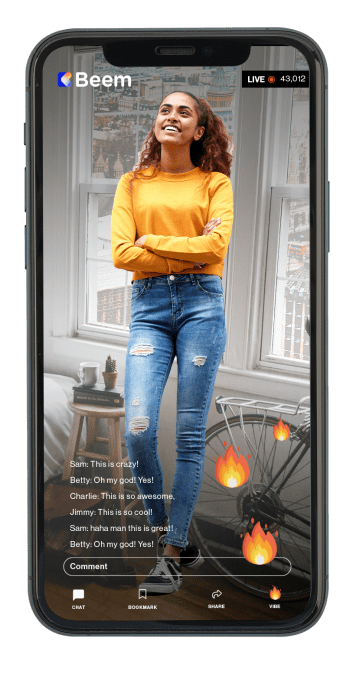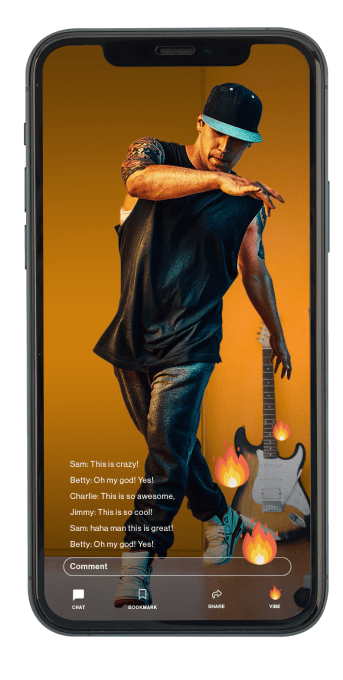Inteligencia Artificial
¿Cuál es el siguiente paso más allá de las llamadas Zoom y FaceTime? ¿Qué tal transmitirse de un dispositivo a otro en tiempo real usando la realidad aumentada? Esa es la premisa detrás de una startup llamada Beem que anuncia su primera aplicación para clientes, con una ronda inicial de 4 millones de dólares y su plan a largo plazo para convertirse en una tecnología de comunicaciones para las gafas Realidad Aumentada (AR) del futuro.
Los clientes conocen la tecnología AR gracias a las interacciones con Snapchat Lenses y TikTok Effects, a través de juegos móviles como Pokémon Go y al visualizar productos que están considerando comprar, como muebles a colocar en su habitación o maquillaje que se prueban virtualmente a través de un filtro AR. Pero usar AR para la telepresencia, como pretende Beem, no es un caso de uso común.
La idea de la puesta en marcha proviene de un fundador que creció sin mucho acceso a la tecnología. El director ejecutivo de Beem, Janosch Amstutz, describe a sus padres como «hippies» que vivían en un pequeño pueblo costero australiano, Byron Bay, donde criaban vacas y gallinas, usaban energía solar, recolectaban agua de lluvia y ni siquiera tenían teléfono, solo una radio de dos vías que la comunidad compartiría.
“Ponemos un gran énfasis en la comunicación cara a cara”, explica sobre la falta de tecnología moderna en su entorno.
Mientras tanto, las comunicaciones continuaron evolucionando desde los teléfonos domésticos hasta los teléfonos celulares y Skype. “Pero luego nos detuvimos”, dice Amstutz. “La premisa de Beem es que habrá un próximo paso inevitable en la forma en que los humanos se comunican digitalmente, que es más creíble y más inmersivo que hacer una videollamada”.

Amstutz inicialmente se rebeló contra su educación al trabajar en el comercio de productos básicos físicos en la industria del acero. Pero no encontró el trabajo satisfactorio. Eventualmente se dio cuenta de que quería hacer otra cosa y, específicamente, quería abordar el problema de la evolución de la comunicación moderna.
El fundador reunió a un equipo de informáticos e investigadores para trabajar en el concepto, que hoy incluye al Jefe de Producto Damián Hickey, anteriormente jefe de producto en AR Pioneer Blippar; y Denis Islamov, co-fundador y CTO, cuya experiencia es en matemáticas aplicadas y física.
Tras su fundación oficial en 2017, Beem (anteriormente HoloMe) no se dirigía completamente al mercado de consumo. En cambio, desarrolló proyectos y campañas de realidad aumentada para marcas, empresas y otras organizaciones. Ejemplos son las campañas de Vogue, Carolina Herrera, Hermes, Louis Vuitton, H&M, Forever 21, Warner Music, LADBible (en asociación con KSI y Craig David), el ejército británico, TEDx y muchos otros.
Durante este tiempo, la tecnología de Beem se usó para transmitir la música de un artista en AR, realizar una conferencia en vivo a los hogares de los usuarios en AR, crear «pasarelas virtuales» y crear otros tipos de experiencias AR para sus clientes.
Esta experiencia permitió a Beem mantenerse mientras probaba y avanzaba en su tecnología, pero la empresa nunca tuvo la intención de ser un estudio de desarrollo, dice Amstutz, quería ofrecer una experiencia de consumo.
Con la aplicación móvil de Beem, el objetivo es poner este tipo de AR en vivo, o experiencia similar a 3D, en manos de los clientes finales.
Para trabajar, los usuarios descargan la aplicación Beem para iOS o Android y se posicionan en el visor de la cámara ya sea montando el teléfono para capturar el marco completo o haciendo que un tercero los grabe. Beem toma el video, segmenta al humano en el video lejos del fondo utilizando sus algoritmos de visión por computadora patentados y su infraestructura en la nube, procesa el activo en tiempo real y lo empaqueta para el espectador.
El destinatario recibe el enlace que abre en el navegador de su dispositivo móvil, donde se le dirige a un micrositio que se activa para cada interacción de estilo AR. Beem accede al acelerómetro del teléfono, lo que permite que los cálculos en el servidor sesguen y transformen la transmisión de video del remitente en su propio espacio para darle la ilusión de tridimensionalidad.
El destinatario levanta su teléfono y coloca a la persona «transmitida en vivo» en su propio espacio tocando un punto en el piso, como lo hace con otras herramientas AR.

El resultado final es lo que parece ser una especie de holograma de la persona en el espacio del que visiona, hablando con él en tiempo real. Puede acercar a la persona o moverla, pero no puede verla desde todos los lados, ya que ese aspecto no se capturó en el video original. La calidad no es tan buena como, digamos, ese lindo AR en TikTok o los animales AR de Google pero es inteligente ya que es en vivo.
“No necesitamos ser súper técnicos… Necesitamos que la mente del espectador crea que lo que está viendo es un ser humano real y eso es suficiente”, dice Amstutz.
Los usuarios de Beem pueden usar la aplicación para organizar «conferencias», como llamadas AR Zoom, donde transmiten la versión holográfica de sí mismos hasta 25 personas con audio bidireccional. También pueden lanzar transmisiones en vivo unidireccionales a una audiencia más amplia o enviar mensajes de video pregrabados.
Beem ha solicitado patentes sobre la infraestructura de su motor y patentes específicas sobre diferentes piezas de su tecnología, como la segmentación de video, su experiencia web patentada y su método para crear experiencias similares a 3D sin que «realmente» sea 3D. Dos, hasta el momento, se han conseguido.
Hasta la fecha, la aplicación ha sido adoptada por algunos TikTokers, incluidos Lev Cameron, Jake Joseph Everett-Rosey Miguel Fallon. En el Reino Unido, Beem también se asoció con una conjunto de escuelas que probó la tecnología para las comunicaciones entre maestros y estudiantes, con planes para una implementación con 750 000 estudiantes. Durante el Día de San Valentín, los usuarios de Beem enviaron más de 1500 mensajes AR.
Beem ahora tiene una cadencia de alrededor de 500 mensajes por día y ha visto alrededor de 14,2 millones de visitas de «beems» en las últimas seis semanas, dice la compañía.
Sin embargo, la realidad es que el caso de uso del consumidor de Beem sigue siendo un tanto engorroso: debe montar el teléfono o hacer que alguien lo sostenga, grabarse y, al grabar un mensaje, hubo un retraso de un par de minutos mientras se procesa antes de que el enlace pueda ser compartido.
Sin embargo, Amstutz dice que el caso de uso ideal de Beem no será el teléfono móvil.
“La circunstancia ideal para que ocurra la telepresencia bidireccional es usar un par de gafas de realidad aumentada y simplemente tener una cámara web de seguimiento en la habitación”, explica. «Así que básicamente podrías dar ordenes por voz a las gafas… y luego la cámara web de seguimiento sabrá que es hora de rastrearme y grabarme, enviarme a ti, y te veré en mi espacio al mismo tiempo y viceversa».
El fundador dice que Beem tiene un prototipo de una experiencia de gafas AR en la que está trabajando para un conjunto de gafas AR, desarrollado por una empresa no revelada y un importante proveedor de chips. Pero, en última instancia, Beem quiere llevar este sistema a cualquier gafa AR en el futuro.
Junto con el lanzamiento de su aplicación para el consumidor, Beem anuncia 4 millones de dólares en fondos iniciales de 5 Lion, Ascension Ventures, Grouport Ventures, Inertia Ventures, Lior Messika y otros inversores estratégicos. Los fondos se destinarán a hacer crecer el equipo y desarrollar aún más su producto para que esté listo para las gafas AR en los mercados de consumo.
“La innovación en AR está creando enormes oportunidades para una variedad de mercados diferentes, y el potencial de impacto de AR es colosal”, dijo el inversionista de Beem, Lior Messika. “La tecnología de Beem crea la infraestructura a través de la cual AR puede volverse verdaderamente accesible y viral. El cambio global a lo digital está ocurriendo rápidamente y Beem está a la vanguardia”, añadió.

